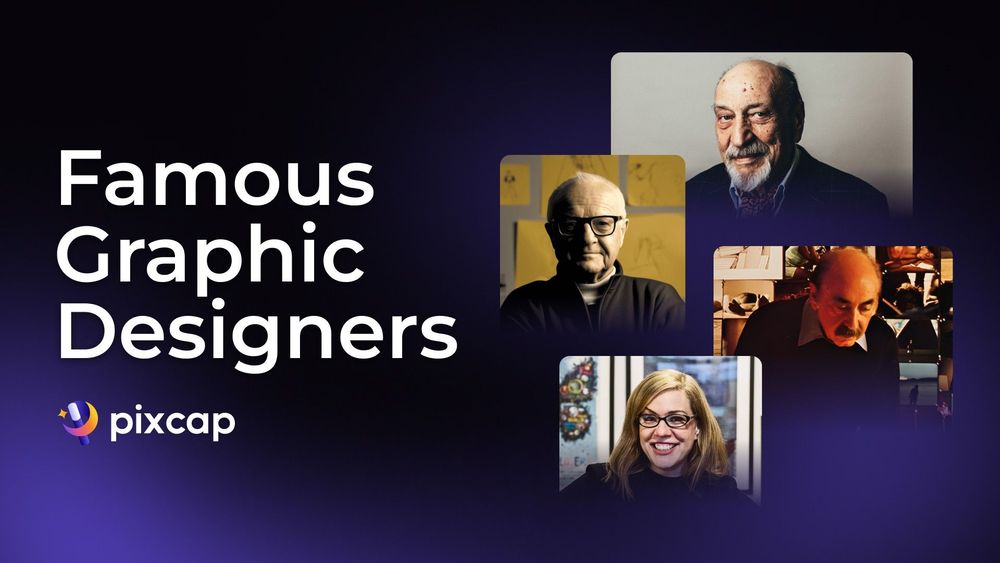Even though it might seem like the graphic design industry is a fairly new field, it's actually been around for a very long time. This area has grown and evolved over hundreds of years thanks to the hard work of many designers.
To honor this long and rich history, we've put together a list of 20 famous graphic designers who have left their mark on the world of graphic design. These individuals have worked in various aspects of the field, from creating fonts and magazine layouts to designing album covers and political posters. Each one of them has contributed to shaping the industry with their creativity and excellent designs.
20 Most Famous Graphic Designers of All Time
Now, let's take a closer look at these 20 notable graphic designers and the important lessons we can learn from their experiences.
Paul Rand: The Master of Modern Design
Paul Rand is one of the most famous graphic designers, synonymous with the rise of modern graphic design. Through his pioneering work at the intersection of design and business, he established visual identities for giants like IBM, UPS, and ABC. His legacy among logo designers is a testament to the power of simplicity, the beauty of the logo, and the functionality of form. Rand believed that a corporate logo should be as recognizable as a person's signature, and indeed, his work ensured this vision became a staple of modern branding.

Saul Bass: Shaping Reels and Realities with Design
Bass is the American graphic designer behind the iconic film title sequences for Hitchcock's classics such as 'Vertigo' and 'Psycho', which not only set the stage for the narrative but also redefined film design. His corporate logos, including Bell Telephone and Quaker Oats, speak to his ability to distill complex ideas into a single evocative graphic design. Combining aesthetics with storytelling, Bass masterfully crafted works that transcend time.

Milton Glaser: Love for New York, Love for Design
Milton Glaser's arresting visual language and unyielding passion for design continue to resonate globally. His "I ❤ NY" logo is an emblem of the city, while his co-founding of New York Magazine offers a blend of culture, politics, and artistic expression. He was a graphic design artist who believed that design should reflect the time, and his work continues to stand as a mirror to the changing social landscape.

Massimo Vignelli: Designing a Timeless Legacy
Vignelli's influence pervaded every aspect of design, from books to furniture, but he is a famous graphic designer perhaps best known for the New York City subway map and the American Airlines logo. His aesthetic principles, rooted in minimalism and timelessness, have become guiding lights for aspiring designers. For Vignelli, discipline in design was a virtue, and his work exemplified the beauty of a singular, well-crafted idea.

Debbie Millman: A Voice in Design Conversation
Millman's voice transcends the page and screen, shaping the conversation around branding and typography. She has been a prolific author, educator, and, her podcast, Design Matters, a platform for deeper design discussions. Her work is a fusion of thoughtful strategy and daring execution, reflecting her belief that design must engage in a dialogue with the viewer.
Chip Kidd: The Alchemist of Book Design
Kidd has the uncanny ability to distill the rich essence of a novel into a single, striking visual. His iconic book covers, which adorn the works of authors like Haruki Murakami and David Sedaris, are testaments to his skill as both graphic designer, and storyteller. His approach to design bends genres, mixing whimsy with contemporary art, and his vision has reinvigorated the book as a precious art form.
David Carson: The Dean of Deconstruction
David Carson's work for Ray Gun magazine broke the shackles of traditional graphic design. His love for experimentation and the unconventional brought about a new wave in design, particularly typography. His layouts, often raw and chaotic, were a rebellion against the status quo, inspiring a generation to find beauty in the irregular and messages in the messy.
Experiment the design style with this poster template.

Stefan Sagmeister: Provoking Thought through Play
Stefan Sagmeister sways from the conventional, creating designs that often teeter between the profound and the playful. His works thrive on experimentation, challenging viewers with their ideas and execution. His pursuit of happiness and beauty, as seen through his 'The Happy Show' and 'Beauty Exhibition', extends an invitation for viewers to engage with design on a deeper, emotional level.
Sagmeister & Walsh: The Dynamic Design Duo
The collaborative force of the two well known graphic designers, Jessica Walsh and Stefan Sagmeister brings forth a synergy that ignites the canvas. Their creations stand as bold proclamations in a world of passive designs, full of vibrant colors and daring concepts. Together, they've tackled projects that defy traditional categorizations, bridging the gap between art and commerce with every stroke of their designs.
Check out It's Friday colorful poster template.

Paula Scher: The Cartographer of Culture
Paula Scher's typographic cartography gives tangible form to intangible cultural landscapes. Her maps of locales and brands are complex typographic networks that tell vivid stories through a chaotic beauty. Scher's expressive typography is deeply bold and daring, serving as inspiration for those looking to break boundaries within the confines of the page.
Michael Bierut: The Chronicler of Cities
Bierut is a contemporary graphic designer whose work at Pentagram reflects his fascination with the urban experience, manifesting itself through his designs for cities like New York, London, and others. His iconic logos and brand identity are testaments to his belief that a successful design should be straightforward and enduring. Bierut's designs capture the essence of the place, distilling its narrative into a visual icon.
Erik Spiekermann: Crafting the Typeface of Tomorrow
Erik Spiekermann is one of the most famous modern typographers of all time. His work in experimental typography goes beyond the mere creation of fonts; it touches the intersection of legibility and innovation. His typefaces like FF Meta are as functional as aesthetically pleasing, a testament to the design principles he propagates. His contribution to the world of typography is seminal, offering a fount of knowledge and a sea of ideas to those navigating the world of letters.
Ellen Lupton: Educator, Curator, Communicator
Lupton's work in design education and curation has been a guiding light for many graphic designers. Her books on design theory and history are not just academic; they are voices of encouragement and practitioners' manuals for design exploration. Ellen Lupton's diverse contributions paint a picture of design that is multi-faceted and richly detailed, reflecting the depth of her engagement with the medium.
Start practicing educational design with this Online Learning Academy Infographic.

Jonathan Barnbrook: The Design Maverick
Barnbrook's fusion of typography and design with music and culture has given rise to truly unique and irrepressible works. His collaborations with David Bowie for album covers are as mesmerizing as they are evocative. Barnbrook's designs often provoke thought and push boundaries, standing in stark contrast to the sea of conformity in modern art and design.
Neville Brody: The Punk Rock Progenitor of Design
Brody's electrifying and rebellious designs for The Face magazine helped define the punk and post-punk era, both in aesthetics and attitude. His typefaces and layouts are aggressive and in-your-face, challenging traditional notions of beauty and legibility. Neville Brody's work is a testament to the idea that design is a tool for cultural defiance, a statement against the status quo.
Lance Wyman: The Unsung Design Hero
Wyman's work for the 1968 Mexico Olympics is a testament to his ability to create cohesive and celebratory designs on a massive scale. The logos and pictograms he created still resonate as some of the most successful in Olympic history. Lance Wyman's work showcases the power of graphic design to unite and inspire on a global stage, capturing the essence of sport and spectacle.
Anthea Hamilton: Designing for the Body and Beyond
Hamilton is a famous graphic designer whose design work often eschews traditional forms, playing instead with fashion and the human body. Her costume designs and provocative exhibitions challenge notions of what design is and where it actually resides. Anthea Hamilton's work sits at the avant-garde of contemporary design, pushing the envelope and exploring the body as a locus for art and design expression.
Mirko Ilic: Combining Cultures with Design
With work that intertwines international aesthetics, political satire, and social commentary, Mirko Ilic remains at the cutting edge of graphic design. His seminal publications and illustrations speak to a world that is both interconnected and conflicted, each drawing and typographic construct a mirror reflecting our collective sights, sounds, and sensibilities.
Theodor Kittelsen: Designing for Dreams
Kittelsen's folklore-inspired designs, deeply rooted in Norwegian tales and myths, present a vision of design heavily influenced by personal narrative and cultural heritage. His illustrations have long adorned the stories of trolls, and the infamous 'Black Death,' offering a gateway into a world that is simultaneously enchanting and eerie, a world where dreams and design unite.
Pamela Colman Smith: The Tarot Card Designer
Smith's designs for the Rider-Waite Tarot deck have been a source of fascination for centuries, a visual repository of archetypal symbols and their meanings. Her illustrations have provided a canvas for the mystical and the magical, a chiaroscuro of the unknown and the unknowable. Pamela Colman Smith's designs are a treasure trove of symbolism, offering a visual lexicon that is at once familiar and fantastic.
Final Thoughts
These 20 best graphic designers, amongst many others, serve not just as icons within the field of graphic design, but as visionaries who have had a significant impact on the design world at large. Their work is a study in how design, when undertaken with passion and purpose, can leave an indelible mark on society, culture, and the individual.
Design is a vast and varied field, and these designers represent a mere fraction of the boundless creativity that it contains. Whether you are a fledgling graphic designer, a seasoned professional, or simply someone with an appreciation for the aesthetic, the sum of these designers' work is both a palette and a pathway. It's an inspired beginning for contemporary designers, those who are on a quest not just to create, but to communicate and to inspire.




